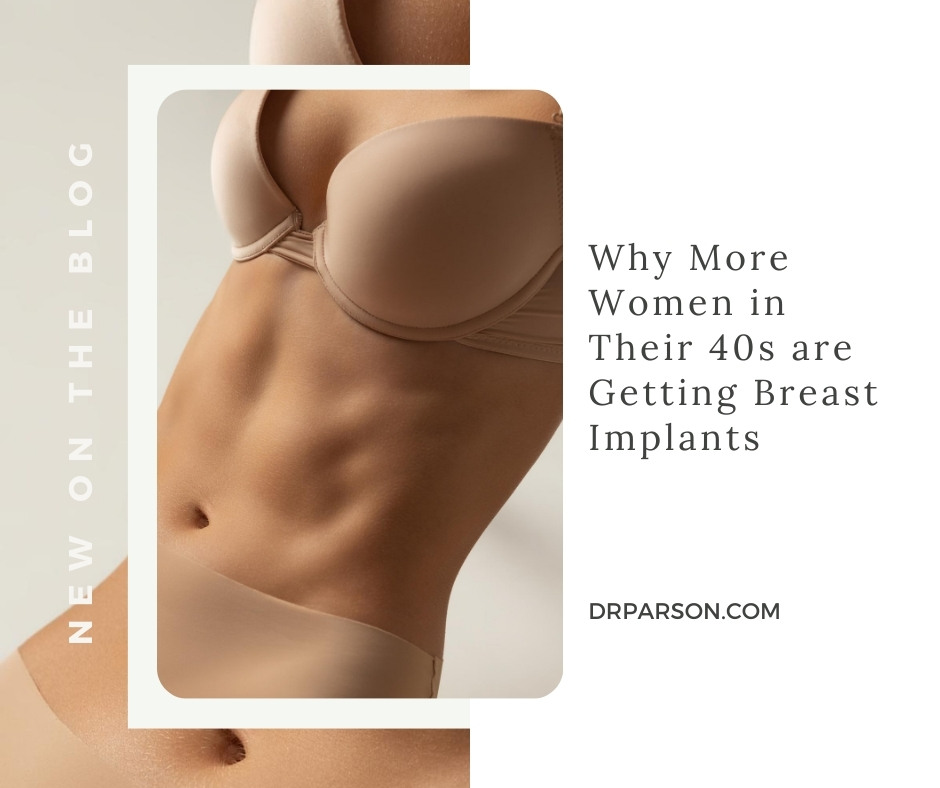
02 Sep Why More Women in Their 40s are Getting Breast Implants
Why do so many people think the “type of person” who gets breast implants is young—usually in their twenties? There are plenty of clients in that age range, but at Dr. Shaun Parson Plastic Surgery & Skin Center and around the world, there is an increasing number of women in their 40s, 50s, and better opting for breast augmentation. The reason is simple: as women age, their breast profile changes (especially for those who have had children). You may have been happy with your cup size in your 20s, but a “deflated” look can begin to appear around age 40. If you notice that most of your breast volume is at the bottom, a breast lift might not be enough to give you the results you want. Breast implants can increase overall size, but they can also help improve and distribute volume more evenly.
Breast lifts and breast augmentation are the two most common types of cosmetic breast surgery. Sometimes they are recommended simultaneously. A breast lift removes excess tissue that causes laxity and usually requires repositioning of the nipple. There are many different types of incisions that your surgeon might recommend for a breast lift. Breast augmentation improves the size, shape, volume, and profile of the breast via the insertion of breast implants. Many clients are pleasantly surprised to learn that the incisions for breast implants are usually quite small. In fact, most silicone breast implants require an incision of less than two inches per breast while saline incisions can be even smaller. In most cases, no nipple repositioning is needed for breast augmentation.
The Right Age for Breast Augmentation
There is no ideal age for breast augmentation. As long as you are a healthy adult, you are probably a good candidate. Some women prefer to wait until they are done breastfeeding to consider breast implants, although there are many women who breastfeed with implants. Ultimately, the “right age” is up to you. However, the uptick of women who are 40+ getting breast implants makes sense since most are done having children (thus eliminating the need to think about future breastfeeding plans). Also, this is the age when volume loss at the top of the breasts begins to be noticeable.
Clients also want to know how long breast implants “last” and there is no one size fits all answer. Many breast implant manufacturers put an “expiration date” on breast implants, but this is not like a sell-by date at the supermarket. As long as you continue to be happy with your implants and they are in good shape, implants can last for several years. In fact, there are instances where implants have been left in place for decades. Still, a lot of women change their aesthetic preferences every 10–15 years or so, and may decide to change the type, size, shape, or location of their breast implants around that time.
What to Expect with Breast Implants
Every surgery is different and your surgeon will discuss your timeline with you. However, most patients can return to sedentary activities (including desk jobs) after about one week. Some gentle exercises typically commence at weeks 2 – 3, and more aggressive exercises (including running and weight lifting) can restart after 6 – 8 weeks. The most severe soreness occurs in the first five days. After this point, a lot of patients feel back to their usual selves, though of course healing is still taking place. It can take up to six months for complete healing.
You may experience some numbness and/or increased sensitivity after breast augmentation, but this is common and temporary. Swelling is also common, so hold off on purchasing new bras and tops for at least three months after your surgery. At three months, the “drop and fluff” occurs. This is when the implants settle and spread a bit into their intended, ideal position.
Getting Ready for Breast Augmentation
Little prep work needs to be done for this surgery, though you’ll need to stop smoking for a few weeks prior to breast augmentation. Some medications are contraindicated with cosmetic surgery, so be sure to discuss this with your surgeon and GP. Otherwise, most people take 1 – 2 weeks off of work to recover. It is important to have at least two doctor-recommended compression bras post-op. You will probably be dressed in one during your surgery, but it’s a good idea to have the second one at home and waiting for you so that you always have a clean option. These compression bras are worn anywhere from 6 – 10 weeks after the surgery to decrease swelling, encourage proper placement, and increase your comfort.
To learn more about breast augmentation and other cosmetic surgeries at Dr. Shaun Parson Plastic Surgery & Skin Center, call the office today at (480) 282-8386 or complete the online contact form.
